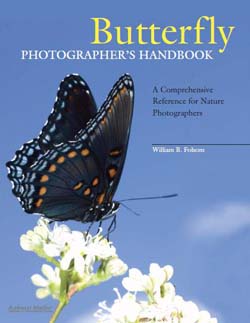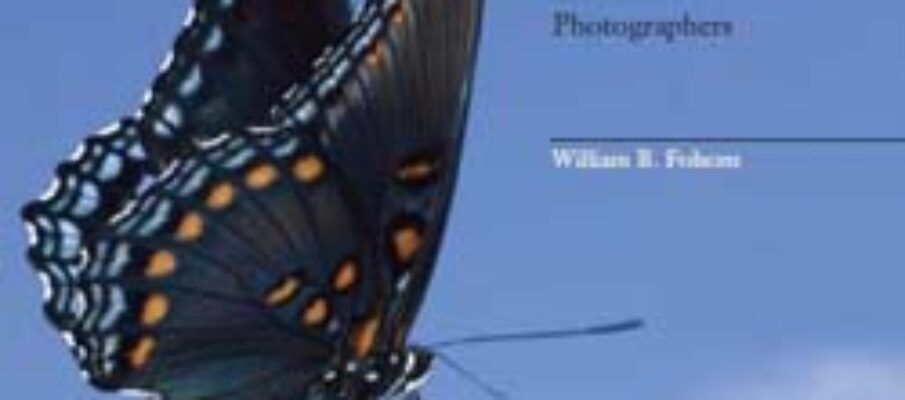Of all the popular photographic subjects in nature, few can rival butterflies in terms of color, variety, and charisma; however few subjects also present the photographer with more technical challenges. From their spectacularly colorful wings that can be maddeningly difficult to get into proper focus to their flighty feeding habits that cause them to move to another flower a split second before the shutter release button is depressed, butterfly photography can test photographic skills in ways few other nature subjects can. Therefore if one is to embark upon any serious attempt, be it amateur or professional, artistic or scientific, at digitally recording images of butterflies, the availability of a wise and experienced teacher who has mastered the techniques needed to do sosuccessfully is invaluable. William B. Folsom is such a teacher and his Butterfly Photographer’s Handbook: A Comprehensive Reference for Nature Photographers is just such a collection of wisdom and experience.
 As an understanding of one’s photographic subject is essential for any nature photographer, Folsom’s handbook begins with a presentation of the natural history of butterflies, including basic explanations of their anatomy, biology, and the basic groupings within the two butterfly taxonomic superfamilies Papilionoidea and Hesperioidea. (In keeping with the book’s title, discussions of and references to moths are essentially non-existent; a good choice on the part of the author as photography of this larger portion of the Lepidoptera requires a significant number of additional and highly specialized techniques likely to be of little interest or use to any but specialists.)
As an understanding of one’s photographic subject is essential for any nature photographer, Folsom’s handbook begins with a presentation of the natural history of butterflies, including basic explanations of their anatomy, biology, and the basic groupings within the two butterfly taxonomic superfamilies Papilionoidea and Hesperioidea. (In keeping with the book’s title, discussions of and references to moths are essentially non-existent; a good choice on the part of the author as photography of this larger portion of the Lepidoptera requires a significant number of additional and highly specialized techniques likely to be of little interest or use to any but specialists.)
From this overview of the subjects themselves Folsom transitions into more detailed explanations of the life cycle and daily habits of butterflies, framing the information in reference to the utility of such knowledge to the photographer. He also includes some very useful information on how the photographer should behave around his or her intended subjects – such as explaining effective methods of close approach through the use of the “fright” and “flight” zone structure, and the use of the move and focus technique.
Finally, Folsom covers the various technical aspects of photographing butterflies, including his recommendations for selecting the right equipment for the task. While not formally endorsing Nikon, Folsom is candid as to his personal use of that brand of camera bodies and lenses, thus his references to particular lens configurations are most often given in reference to Nikon models (users of other camera brands should have little trouble translating these references to similar products in their own preferred brand’s product line). One particular equipment recommendation he makes, that of using telephoto zoom lenses over dedicated macro lenses, might initially strike some readers as unusual; however Folsom’s rationale for this choice is well reasoned and explained so effectively that some readers already possessing dedicated macro lenses might find themselves suddenly contemplating the purchase of a new addition to their camera bags.
Even more important that the selection of the right equipment, of course, is the knowledge of how to use it most effectively for the purpose at hand, and in this area Folsom’s experience and wisdom truly shine. From advice on selecting the right settings to use for the best results to instruction on techniques he has discovered to provide the greatest chances for success in the field, most every reader from the novice to the professional is likely to find something here that was previously unknown to them. One particularly useful technique Folsom explains concerns a very handy field method of determining the appropriate ISO settings for the lighting conditions under which the photographic session is taking place. Another concerns finding the best location on which to position the focal point of the image for best results (it’s not necessarily what many people might think).
Just as with any type of nature photography, photographing butterflies can be challenging and guarantees of success are never possible – even for the most experienced of photographers. However the time spent in reading William B. Folsom’s Butterfly Photographer’s Handbook, taking note of what it presents, and practicing the techniques it describes will very likely be found to have been more than worth the while in increasing the photographer’s chances of success in the field – both in regard to increasing the overall number of useable images recorded and in elevating the level of quality to be found in those images themselves.
 Title: Butterfly Photographer’s Handbook: A Comprehensive Reference for Nature Photographers
Title: Butterfly Photographer’s Handbook: A Comprehensive Reference for Nature Photographers
Author: William B. Folsom
Publisher: Amherst Media
Format: paperback, 125 pages
ISBN: 9781584282471
In accordance with Federal Trade Commission 16 CFR Part 255, it is disclosed that the copy of the book read in order to produce this review was provided gratis to the reviewer by the publisher.
If you enjoyed reading this, please consider signing up for The Well-read Naturalist's newsletter. You'll receive a helpful list of recently published reviews, short essays, and notes about books in your e-mail inbox once each fortnight.

